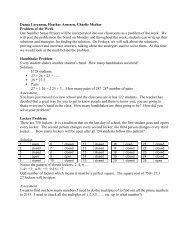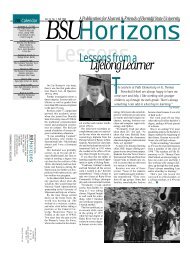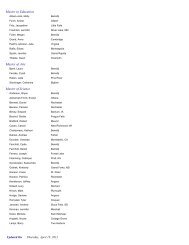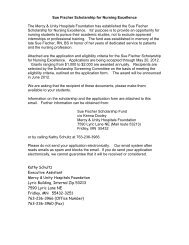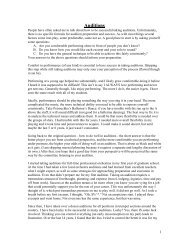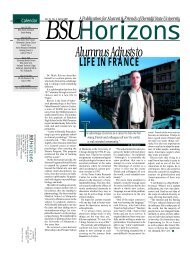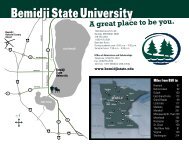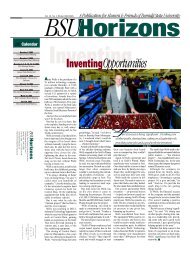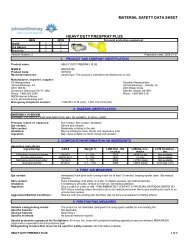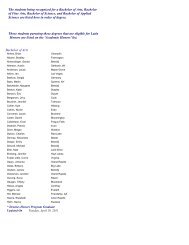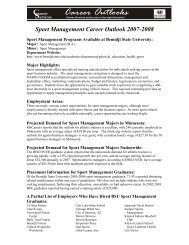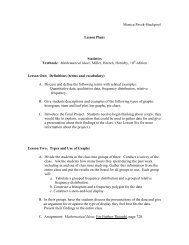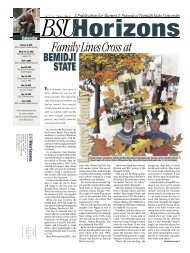INTERNATIONAL - Bemidji State University
INTERNATIONAL - Bemidji State University
INTERNATIONAL - Bemidji State University
You also want an ePaper? Increase the reach of your titles
YUMPU automatically turns print PDFs into web optimized ePapers that Google loves.
including the Thad Jones/Mel Lewis Band. But it was in the popular groundbreaking group Blood, Sweat And Tears that Soloff’s trumpet solos<br />
became an indelible part of American culture. He was an integral part of the band from 1968 to 1973, racking up 9 Gold records, a Grammy for “Record<br />
of The Year” (1969) and creating those searing horn lines in “Spinning Wheel.” Following his time with Blood, Sweat And Tears, Soloff demonstrated<br />
his distinguished abilities in the studio. The depth of recordings that include his work illustrate why he is consistently in demand. Some of those<br />
projects include releases by; Roy Ayers, Bob Belden, George Benson, Benny Carter, Stanley Clarke, Paquito D’Rivera, Miles Davis/Quincy Jones (Live<br />
At Montreux), Mercer Ellington, Grant Green, Lionel Hampton, Bob James, Herbie Mann, Tania Maria, Carmen McRae, Laura Nyro, Jaco Pastorius,<br />
Mongo Santamaria, Little Jimmy Scott, Wayne Shorter and Stanley Turrentine.<br />
This classically trained jazz player however is indeed a chameleon in front of the microphone, participating in sessions and concerts for some of pop’s<br />
most respected figures namely; Tony Bennett, Elvis Costello, Marianne Faithful, Aretha Franklin, Lou Reed, Frank Sinatra, Paul Simon and Barbra<br />
Streisand. Defying strict classification, he can also be heard on recordings by Phillip Glass and Kip Hanrahan as well as Blues legends John Mayall<br />
and Dr. John. A brief listing of the film soundtracks that have Soloff in the mix include; The Big Lebowski, Lethal Weapon 3, Brighton Beach Memoirs,<br />
Carlito’s Way, The Color of Money, Coming To America, The Mambo Kings, Meet Joe Black, National Lampoon’s Vacation, Tender Mercies, and Maid<br />
In Manhattan. Also a respected educator, he continues to appear at universities around the country where he utilizes the Gil Evans arrangements<br />
that have been an essential element of his repertoire through the years. He has been on the faculty of the Manhattan School of Music for nearly 20<br />
years and has been an adjunct faculty member at Julliard and New School. Lew Soloff plays exclusively on Sonaré Bb trumpets made by Blessing.<br />
MArvINSTAmm<br />
Throughout his distinguished career, Marvin Stamm has been praised for both the art and the craft of trumpet<br />
playing. Leonard Feather stated that “Mr. Stamm is an accomplished performer whose technical skill is used as a<br />
means to stimulating original ends.” While attending North Texas <strong>State</strong> <strong>University</strong>, a school noted for its innovative<br />
Lab Band program Mr. Stamm was discovered by Stan Kenton. Upon graduating, Stamm performed with the<br />
Kenton’s orchestra as the jazz trumpet soloist 1961-1962, recording five albums with the orchestra. In 1965-1966,<br />
he toured worldwide with Woody Herman.<br />
Marvin Stamm settled in New York City in late 1966, quickly establishing himself as a busy jazz and studio trumpeter.<br />
New York was bustling with jazz activity during that period, and Stamm performed at key venues with many of the<br />
significant players in the business. He gained considerable recognition for his playing with the Thad Jones/Mel<br />
Lewis Jazz Orchestra (1966-1972) and the Duke Pearson Big Band (1967-1970), as well as performing with Frank<br />
Sinatra (1973-1974) and the Benny Goodman Sextet (1974-1975), among others. Stamm was also a recognized firstcall<br />
studio player (1966-1989). Some of the jazz artists with whom he recorded include Bill Evans, Quincy Jones,<br />
Oliver Nelson, Duke Pearson, Thad Jones, Wes Montgomery, Freddie Hubbard, Stanley Turrentine, Patrick Williams,<br />
Michel Legrand, Lena Horne, Frank Foster, Paul Desmond, George Benson, and many other popular artists of the<br />
period as well. Eschewing the lucrative studio scene in the late ‘80s, Mr. Stamm has focused his attention on his first love, playing jazz. Over his<br />
career, he has been a member of John Lewis’ American Jazz Orchestra, the Bob Mintzer Band, the George Gruntz Concert Jazz Band, Louis Bellson’s<br />
big band and/or quintet and, on a number of occasions, performed with the big band of composer Maria Schneider.<br />
Currently, Mr. Stamm spends much of the year touring. His activities include performing as a soloist, touring with his jazz quartet, and playing in<br />
duo with pianist Bill Mays. Stamm and Mays recently formed and are touring with a new group, the Inventions Trio, which includes cellist Alisa Horn.<br />
Stamm performs occasionally with symphony orchestras and maintains his ties with the George Gruntz Concert Jazz Band. At home, Mr. Stamm<br />
participates and performs with the Westchester Jazz Orchestra, a big band made up of some of the finest jazz musicians in the New York area, all<br />
living in Westchester County and led by composer/arranger Mike Holober.<br />
The critical response to Stamm’s work has been highly enthusiastic. Downbeat reported that “Stamm has a gorgeous tone on the trumpet and<br />
flugelhorn, and he flies through the changes”. JazzTimes said that “the Memphis native has chops and talent in abundance. He can burn on bebop<br />
changes, or mellow out on a ballad, all the time maintaining the lucid consistency that enthusiasm and experience engenders.” Jazz Review states, “It<br />
is a pleasure listening to the work of Marvin Stamm, anytime! Stamm is a musician’s musician, performing flawlessly on his trumpet and flugelhorn.”<br />
Consciously acknowledging his debt to the influence and guidance of former teachers and fellow musicians, Marvin Stamm also commits a good deal<br />
of his time and energies to helping young music students develop their own voices. His involvement in jazz education takes him to universities and high<br />
schools across the U.S. and abroad as a performer, clinician and mentor, perpetuating the traditions of excitement and innovation that jazz represents.<br />
JAMeSTHomPSoN<br />
James Thompson is currently Professor of Trumpet at the Eastman School of Music. He came to this position having<br />
played Principal Trumpet in the Atlanta Symphony Orchestra since September 1990. He has held corresponding<br />
positions with the Phoenix Symphony, the Orchestra of the <strong>State</strong> of Mexico, the National Symphony of Mexico, and<br />
for 14 years, the Montreal Symphony Orchestra. Born in Frankfurt, Germany, he was raised in Phoenix, Arizona<br />
where he began trumpet studies at the age of ten. His principal teachers included Richard Longfield and Roger<br />
Voisin.<br />
Mr. Thompson has been active both as a soloist and a teacher. He has taught trumpet and Brass Ensemble at Northern Arizona <strong>University</strong>, the<br />
National Conservatory of Music in Mexico City, and McGill <strong>University</strong> in Montreal, Canada. He has also performed as soloist with orchestras in North<br />
and South America as well as Europe. In 1979 he competed in the first Maurice Andre International Trumpet Competition and was a prizewinner. He has<br />
made recital tours to Japan, Canada, Spain, Germany, Sweden, Norway, and Latin America. He has also been a guest artist with the Summit Brass, a<br />
brass chamber ensemble made up of members from America’s finest orchestras, and Chicago’s Music of the Baroque.<br />
International Trumpet Guild Program | Page 51



